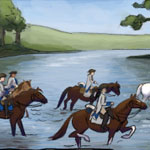Japethe
Japethe is a continent in the northern temperate zone of Corthis on the eastern side of the Levian Sea. To the north, the land fades into the ice-bound wilderness of the Uttermost North, and the continent narrows in the east to an isthmus where it connects with the western wastelands of the continent Shamach. To the south is the shallow and tame Mezinne Sea which separates Japethe from the vast deserts, savannas, and empires of Aphrike.
Japethe is a continent of great mountain ranges and many winding rivers. The Whitecrest Mountains, the largest of the continent's many mountain ranges, curves in a great arc across the interior of Japethe. The range is almost impassible in the west, but it slowly dwindles as it arcs to the east, eventually breaking into two ridges that peter out into the plains of Vaspaar. Steady rainfall from storms blown in from the Levian Ocean provides abundant moisture, while cloaking the westernmost islands in near perpetual mists. Great peninsulas, separated by narrow bays, dominate the southern shoreline of Japethe. The northern coastline is extremely boggy and miles of land can vanish under the ocean when the tide comes in only to rise again as the water recedes.
Japethe is the most recently civilized of the continents of the Old World and its nations are young and vibrant. Each country has a patron great spirit, whose personality and dictates greatly influence the character of each nation. The sole exception is Aileon, whose great spirit vanished several hundred years ago. The great spirits and nations of the north tend to be aggressive and warlike, while those in the south are more cerebral and cultured. The nations of Japethe are currently undergoing a philosophical and economical revolution, causing rapid development in the sciences and encouraging explorers to travel to the far reaches of Corthis in search of spices, wealth, and the unknown.

Alagnon River
One of the longest rivers in Japethe, the Alagnon River flows north then west in a long, curving arc from its headwaters in the uplands of the August Massif to its estuary into the Levian Ocean. The river can be divided into three broad sections. The upper Alagnon cuts through deep valleys of the August Massif, where it is a fast-moving waterway that rushes through gorges and forests. The middle Alagnon has swollen in size from many tributaries but it is still a shallow river that meanders and forks often. The lower Alagnon is so wide that it ceases to be a river and becomes something bigger — a fleuve. It is bounded by wetlands and fens, where the current of the fleuve slows to a crawl.
The Alagnon separates Saronne from Morante on its lower stretch and Saronne from Felaire on its upper portion. The river and its valley is hotly contested, especially between Saronne and Morante. Battlefields are almost as common as towns along the Alagnon, with every bridge or ford being a strategic point. Centuries of conflict have left their mark on the riverside. Ancient fortresses overlooked the Alagnon's slow current until they were replaced by the soaring towers of castles, which were replaced in turn by the squat, earthen embankments of modern citadels.
« Return to the Almanac Index

